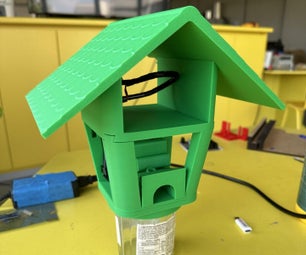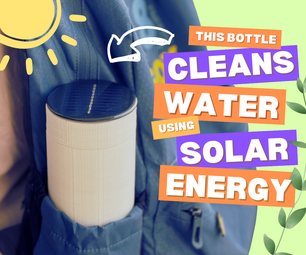Introduction: SMART LED FLASHLIGHT - a Tiny Personal Emergency Light Sensing LED Flashlight, Made From Available Components and Very Simple for Replicate Itself in 20 Minutes.
How it works:
The flashlight turns on automatic for 60 seconds when it senses that the room is dark enough.
To turn on manual light for additional 60 seconds you need to push the RST button.
The Light sensing LED Flashlight is invaluable for emergencies such as power failures or blackouts.
Step 1: The Flashlight Is Invaluable for Emergencies Such As Power Failures or Blackouts.
I have assembly several Flashlight, and have several dozen spear PCB board and components that I can share with any one who wish to make the flashlight.
The instructable contains:
- Flashlight schematic,
- PCB Assembly drawing,
- BOM - Components KIT cost less than $5
- Tools list
- Detailed step-by- step assembling instructions.
Specifications:
- Number of flashlight components: 15
- Color of LED’s light: white
- Number of LEDs: 3
- Light Distance: 2-3 meters
- Size of flashlight : 26.25mm x 20mm x 5mm
- Current consumption :
- LEDs turn ON: 4-5mA
- LEDs turn OFF: 30-45uA
- Battery capacity: 140mAh
- Battery voltage: 3V
- Battery life : up to 6 months (if flashlight turns on 2 times for 60 sec in 24 hours)
- Required skills : knowledge of soldering SMD components
Step 2: Light Sensing LED Flashlight Schematics
The Light sensing LED Flashlight Schematics contains the next blocks:
- 3 White LEDs (LED1 - LED3) and 3 current limit resistors (R1 - R3)
- 16 bit ultra low power micro-controller of firm Texas Instruments (U1)
- Power on (R4 and C1) and manual Reset (S1 push-button) micro-controller circuit
- Light sensor (PH1) and resistor R5 - is voltage divider circuit
- Flashlight battery 3V, 140mAh
Step 3: The Light Sensing LED Flashlight PCB
I ordered the PCB from a Chinese low cost prototype PCB manufacturer.
The PCB Specification are:
- Dimensions: 20mm x 26,25mm
- Layers number :2 Layers
- PCB Type: Normal FR-4 Board
- FR4-TG: TG 130-140
- Thickness: 1.6mm
- Solder Mask: White
- Silkscreen: Black
- Surface Finish: HASL with lead
- Finished Copper: 1 oz Cu
Step 4: The Light Sensing LED Flashlight BOM
All components for assembly Light sensing LED Flashlight I put in a plastic box.
I ordered wholesale quantity of all components.
For myself, I made 4 flashlights and the rest of my Flashlight components put in plastic boxes and share in https://www.tindie.com/products/WihiteRobot/light...
There you will be able to get them at a price lower compared to cost of components purchased for a single flashlight. So if anybody will want build the flashlight I advice first check if remained a spare kits in https://www.tindie.com/products/WihiteRobot/light...
The FLASHLIGHT KIT include all flashlight BOM components (+ 5 spare small SMD) and already programmed micro controller.
Step 5: Tools
- Simple Digital Multi-meter Tester: that can measure Voltage, Current, Resistance, Test a Diode (optional) - use for debugging.
- FLUX Cleaner. Applications: PCBs Cleaner - use for remove flax from PCB after soldering components.Liquid
- Solder Flux - use removing oxide buildup. Helps spread out solder by reducing surface tension.
- Flashlight Components Kit.
- Tin Lead Rosin Core Flux Solder, Diameter : 0.6mm, Material : 60% Sn (Tin) & 40% Pb (Lead) -use to solder electronic components.
- Wire Sponge Soldering Iron Tip Cleaning, - use for cleaning iron tip.
- Desoldering Braid Solder Remover Wick Cable Wire 2.0mm 0.75m - use solder wick to remove the excess solder.
- ESD-Safe PCB Cleaning Brush.
- Simple Soldering Iron 30W-40W, or adjustable temperature soldering iron 60W-90W with the soldering tip suitable for SMD soldering. Soldering iron stand base with sponge.
- Diagonal Wire Cutter - use for cut off the pins of through-hole components.
- Stainless Steel Tweezers - use for hold the SMD components.
Step 6: Soldering Ultra Low Power Micro-controller MSP430 - U1
It is important to solder only in a well ventilated area.
Work areas must be kept free of static generating materials including styrofoam, vinyl, plastic, fabrics and so on.
Pay attention the white line of the U1 should be placed as showed in the picture. U1 first pin should be close to R1.
Step 7: Soldering R1, R2, R3:
Soldering LED’s current limit resistors R1, R2, R3
Step 8: Soldering White Light Emitting Diodes LED1, LED2, LED3
Pay attention to LED direction. The blunt (catted) angles of LEDs should be placed exactly as showed in picture.
The LEDs have a plastic package that that very sensitive to overheating.
Don’t overheat the LEDs.
Step 9: Soldering Reset Circuit Ceramic Capacitor C1
Soldering reset circuit ceramic capacitor C1
Step 10: Soldering Reset Circuit Resistor R4
Soldering reset circuit resistor R4
Step 11: Soldering Resistor R5 of Light Sensing Circuit
Soldering resistor R5 of light sensing circuit
Step 12: Soldering Reset Circuit Push Button S1
Soldering reset circuit push button S1
Step 13: Soldering Light Sensor Photo Resistor PH1
Soldering light sensor photo resistor PH1.
Clean the PCB contact pads by alcohol.
Put the photo-resistor PH1 to PCB.
Put a small amount of solder on one of the two legs of the PH1.
Put a small force down non the part and re-head the one pad to guarantee that the parts is flat against the PCB.
Solder thee other leg of PH1.
Cut of the rest of the PH1 legs by diagonal wire cutter.
Step 14: Soldering Flashlight Battery Holder
Clean the PCB contact pads by alcohol.
Put the battery holder to PCB.
Reference the picture for place battery holder with correct direction.
Put a small amount of solder on one of the two legs of the battery holder.
Put a small force down non the part and re-head the one pad to guarantee that the parts is flat against the PCB.
Solder thee other leg of battery holder.
Step 15: Insert the 3V Battery Into Battery Holder
The battery have positive and negative contacts.
Found the positive contact with (+).
See pictures.Insert the battery into battery holder.
The positive contact should be at battery holder side and the negative battery contact should be at PCB side.
When the battery will be inserted into flashlight the LED1 -LED3 should light up.







